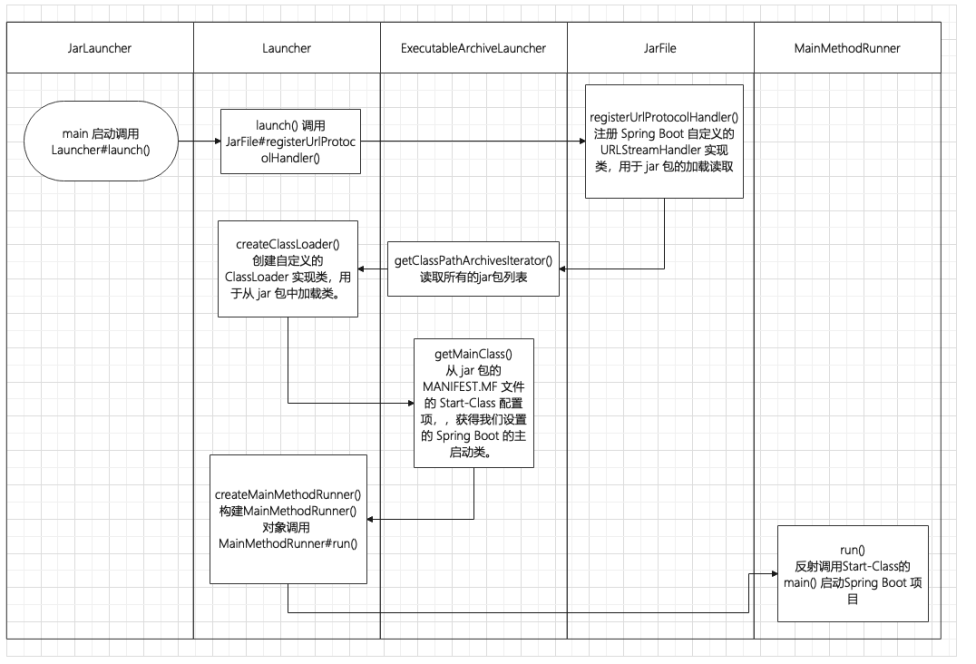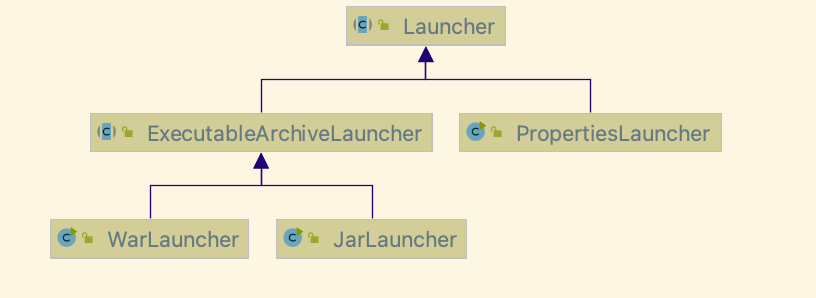可能很多初学者会比较困惑,Spring Boot 是如何做到将应用代码和所有的依赖打包成一个独立的 Jar 包,因为传统的 Java 项目打包成 Jar 包之后,需要通过 -classpath 属性来指定依赖,才能够运行。我们今天就来分析讲解一下 Spring Boot 的启动原理。
1. Spring Boot 打包插件
Spring Boot 提供了一个名叫 spring-boot-maven-plugin 的 maven 项目打包插件,可以方便的将 Spring Boot 项目打成 jar 包。 这样我们就不再需要部署 Tomcat 、Jetty等之类的 Web 服务器容器啦。
我们先看一下 Spring Boot 打包后的结构是什么样的,打开 target 目录我们发现有两个jar包:
- hello-0.0.1-SNAPSHOT.jar:17.3MB
- hello-0.0.1-SNAPSHOT.jar.original:3KB
其中,hello-0.0.1-SNAPSHOT.jar 是通过 Spring Boot 提供的打包插件采用新的格式打成 Fat Jar,包含了所有的依赖;而 hello-0.0.1-SNAPSHOT.jar.original 则是Java原生的打包方式生成的,仅仅只包含了项目本身的内容。
2. SpringBoot FatJar 的组织结构
我们将 Spring Boot 打的可执行 Jar 展开后的结构如下所示:
1 | |
- BOOT-INF目录:包含了我们的项目代码(classes目录),以及所需要的依赖(lib 目录)
- META-INF目录:通过 MANIFEST.MF 文件提供 Jar包的元数据,声明了 jar 的启动类
org.springframework.boot.loader:Spring Boot 的加载器代码,实现的 Jar in Jar 加载的魔法源
我们看到,如果去掉BOOT-INF目录,这将是一个非常普通且标准的Jar包,包括元信息以及可执行的代码部分,其/META-INF/MAINFEST.MF指定了Jar包的启动元信息,org.springframework.boot.loader 执行对应的逻辑操作。
3. MAINFEST.MF 元信息分析
元信息内容如下所示:
1 | |
它相当于一个 Properties 配置文件,每一行都是一个配置项目。重点来看看两个配置项:
- Main-Class 配置项:Java 规定的 jar 包的启动类,这里设置为 spring-boot-loader 项目的 JarLauncher 类,进行 Spring Boot 应用的启动。
- Start-Class 配置项:Spring Boot 规定的主启动类,这里设置为我们定义的 Application 类。
- Spring-Boot-Classes 配置项:指定加载应用类的入口
- Spring-Boot-Lib 配置项: 指定加载应用依赖的库
4. 启动原理
Spring Boot 的启动原理如下图所示:

5. 源码分析
org.springframework.boot.loader.JarLauncher
JarLauncher 类是针对 Spring Boot jar 包的启动类, 完整的类图如下所示:

其中的 WarLauncher 类,是针对 Spring Boot war 包的启动类。 启动类 org.springframework.boot.loader.JarLauncher 并非为项目中引入类,而是 spring-boot-maven-plugin 插件 repackage 追加进去的。
接下来我们先来看一下 JarLauncher 的源码,比较简单,如下图所示:
1 | |
当执行 java -jar 命令或执行解压后的 org.springframework.boot.loader.JarLauncher 类时,JarLauncher 会将 BOOT-INF/classes 下的类文件和 BOOT-INF/lib 下依赖的jar加入到classpath下,后调用 META-INF/MANIFEST.MF 文件 Start-Class 属性 [指向项目中的 com.javanorth.hello.HelloApplicatioin 启动类] 完成应用程序的启动。
JarLauncher 假定依赖项jar包含在 /BOOT-INF/lib 目录中,并且应用程序类包含在 /BOOT-INF/classes 目录中。它的 main 方法调用的则是基类 Launcher 定义的 launch 方法,而 Launcher 是ExecutableArchiveLauncher 的父类。
org.springframework.boot.loader.ExecutableArchiveLauncher
ExecutableArchiveLauncher 是 JarLauncher 的直接父类,继承了 Launcher 基类,并实现部分抽象方法
1 | |
org.springframework.boot.loader.Launcher
如下则是 Launcher 的源码
- launch 方法会首先创建类加载器,而后判断是否 jar 是否在 MANIFEST.MF 文件中设置了 jarmode 属性。
- 如果没有设置,launchClass 的值就来自 getMainClass() 返回,该方法由子类实现,返回 MANIFEST.MF 中配置的 START_CLASS_ATTRIBUTE 属性值
- 调用 createMainMethodRunner 方法,构建一个 MainMethodRunner 对象并调用其 run 方法
jarmode 是创建 docker 镜像时用到的参数,使用该参数是为了生成带有多个 layer 信息的镜像,这里暂不注意
1 | |
org.springframework.boot.loader.MainMethodRunner
从名字可以判断这是一个目标类main方法的执行器,此时的 mainClassName 被赋值为 MANIFEST.MF 中配置的 START_CLASS_ATTRIBUTE 属性值,也就是 com.javanorth.hello.HelloApplication,之后便是通过反射执行 HelloApplication 的 main 方法,从而达到启动 Spring Boot 的效果。
1 | |
总结
- jar 包类似于 zip 压缩文件,只不过相比 zip 文件多了一个 META-INF/MANIFEST.MF 文件,该文件在构建 jar 包时自动创建
- 想要制作可执行 JAR 包,在 MANIFEST.MF 中指定 Main-Class 是关键。使用 java 执行 jar 包的时候,实际上等同于使用 java 命令执行指定的 Main-Class 程序。
- Spring Boot 提供了一个插件 spring-boot-maven-plugin ,用于把程序打包成一个可执行的jar包
- 使用 java -jar 启动 Spring Boot 的 jar 包,首先调用的入口类是 JarLauncher,内部调用 Launcher 的 launch 后构建 MainMethodRunner 对象,最终通过反射调用 HelloApplication 的 main 方法实现启动效果。
[EOF]
